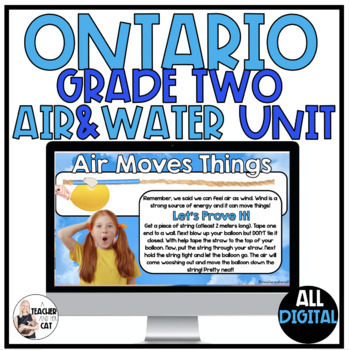Grade 2 Air and Water in the Environment Ontario Digital Science Unit
- Google Drive™ folder

What educators are saying
Description
If you are teaching virtually or want a fantastic set of lessons to guide your science unit on Air and Water in the Environment this is the unit for you!
This fully digital science unit covers all of the Ontario curriculum expectations.
I have added paper copies for most of the slides, so this can be used in person. The paper copies are meant to supplement the slides. Some won't make sense unless you are using the slides with it. Please note this is a digital unit and the paper copies are a bonus!
This includes 62 slides. Some are readings with pictures, some are interactive drag and drop activities and some need typed responses! Alternatively, you can do everything as a class and have students show what they know by writing answers in journals.
Highlights
-Drag and Drop Water Cycle
-Air Pollution/Water Pollution Poster activity (with editable grading criteria)
-Experiments to demonstrate the water cycle, how air takes up space, how air moves
-KWL Chart
-Several "Show What You Know" questions with typed responses required
-Drag and drop "What Uses Air"
-Interactive Water Use Tracker
-Vibrant slides with many real life photos to aid the readings and learning
Please check out the preview before purchasing! :). Please note there are no worksheets with this unit. This is fully digital. Perfect for assigning in Google Classroom. Slides are ONLY interactive in EDIT mode.
Like this? Check out:
-Grade 2: Growth and Changes in Animals Digital Unit
Still have questions? I have answers! Email me at ateacherandhercat@gmail.com
Expectations Covered:
1.1 Assess the impact of human activities on air and water in the environment, taking different points of view into considerations (e.g., the point of view of the parents, children, other community members), and plan a course of action to help keep the air and water in the local community clean
1.2 Assess personal and family uses of water as responsible/efficient or wasteful, and create a plan to reduce the amount of water used, where possible
2.1 Follow established safety procedures during science and technology investigations
2.2 Investigate, through experimentation, the characteristics of air (e.g., air takes up space, has mass) and its uses (e.g., living things breathe air to stay alive; air makes certain activities possible: helps keep a kite flying and a sailboat moving
2.3 Investigate through experimentation, the characteristics of water (e.g., water takes up space, flows or moves when not contained, has mass) and its uses (e.g., living things need water to stay alive; water makes things move: spins a water wheel; water makes certain activities possible: keeps a whitewater raft afloat)
2.4 Investigate the stages of the water cycle, including evaporation (e.g., heat water in a kettle), condensation (e.g., collect the water vapour from the kettle on an overturned mirror), precipitation (e.g. allow the water vapour on the overturned mirror to collect, cool and drop), and collection (e.g., let the dripping water accumulate in a container.
2.5 Investigate the water in the natural environment (e.g., observe and measure precipitation; observe and record cloud formations; observe water flow and describe where it goes; observe a puddle over time and record observations)
2.6 Use appropriate science and technology vocabulary, including solid, liquid, vapour, evaporation, condensation and precipitation, on oral and written communication
2.7 Use a variety of forms (e.g., oral, written, graphic, multimedia) to communicate with different audiences and for a variety of purposes (e.g., create posters or media ads that encourage care and concern for water and air in the community)
3.1 Identify air as a gaseous substance that surrounds us and whose movement we feel as wind
3.2 Identify water as a clear, colorless, odourless, tasteless liquid that exists in three states and that is necessary for the life of most animals and plants
3.3 Describe ways in which living things, including humans, depend on air and water (e.g., most animals, including humans breathe air to stay alive; wind generates energy, disperses seeds; all living things need to drink or adsorb water to stay alive; water is used for washing and bathing, transportation, emergency generation)
3.4 Identify sources of water in the natural and built environment (e.g. natural: oceans, lakes, ponds, streams, sprints, water tables; human-made: wells, sewers, water supply systems, reservoirs, water towers)
3.5 Identify the three states of water in the environment and give examples of each (e.g., solid – visible as ice, snow, sleet, hair, frost; liquid – visible as rain, dew; gas – visible as fog, water vapour) and show how they fit into the water cycle when the temperature of the surrounding environment changes (e.g. heat: evaporation; cooling: condensation and precipitation)
3.6 State reasons why clean water is an increasingly scarce resource in many parts of the world





